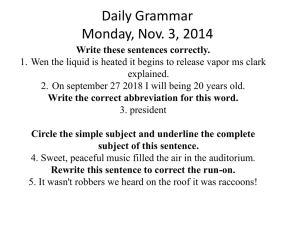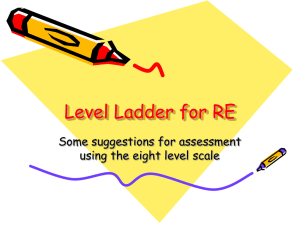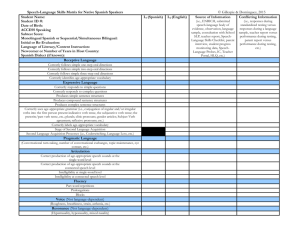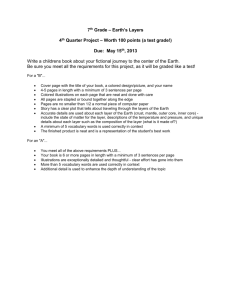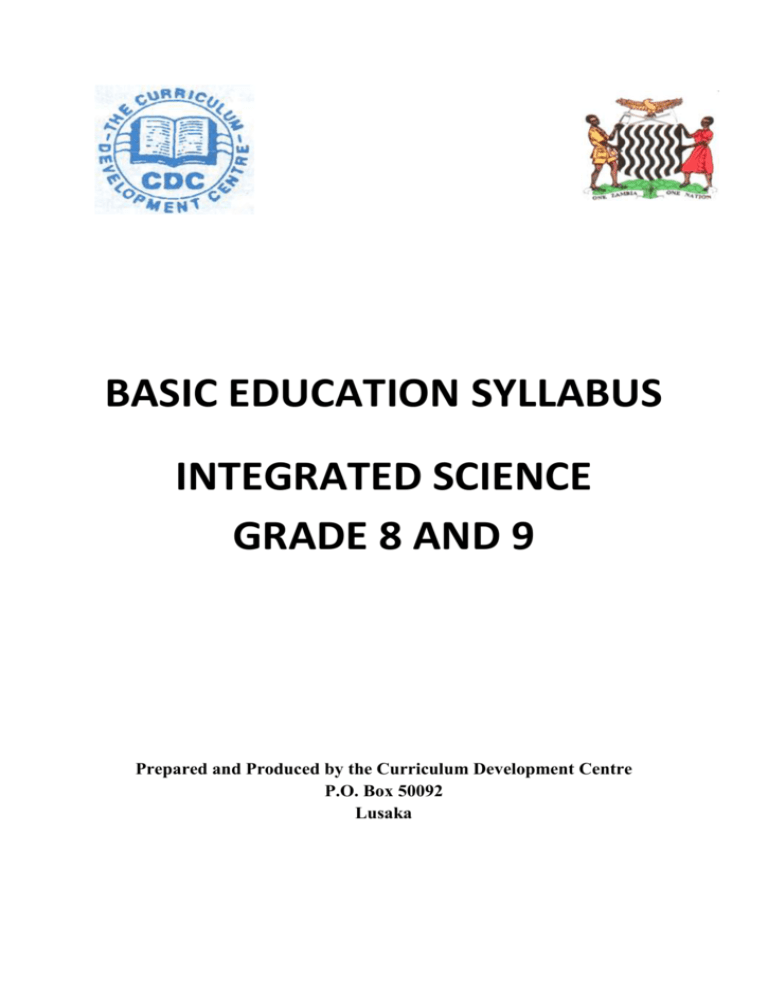
BASIC EDUCATION SYLLABUS
INTEGRATED SCIENCE
GRADE 8 AND 9
Prepared and Produced by the Curriculum Development Centre
P.O. Box 50092
Lusaka
© Curriculum Development Centre
All rights Reserved. No part of this publication may be reproduced, stored in a retrieval
system or transmitted in any form by any means, mechanical, photocopying, recording or
otherwise without the prior permission of the copyright holder.
CONTENTS
Preface....................................................................................................................................(ii)
Introduction:...........................................................................................................................(iii)
Methodology..........................................................................................................................(iii)
General Outcomes.................................................................................................................(vi)
Assessment...........................................................................................................................(vi)
Grade 8..................................................................................................................................1
Unit: 1.0 The Human body....................................................................................................1
Unit: 2.0 Health.....................................................................................................................2
Unit: 3.0 The Environment....................................................................................................3
Unit: 4.0 Plants and animals..................................................................................................4
Unit: 5.0 Materials and energy.............................................................................................5
Grade 9..................................................................................................................................6
Unit: 1.0 The Human body....................................................................................................6
Unit: 2.0 Health.....................................................................................................................7
Unit: 3.0 The Environment....................................................................................................8
Unit: 4.0 Plants and animals..................................................................................................9
Unit: 5.0 Materials and energy..............................................................................................10
i
PREFACE
Since the ability to think Scientifically and understand scientific processes is becoming a
condition for survival in Zambia, there is need for the national education policy to emphasise
the need for learners to develop skills that they can apply in various ways in their
environment.
The Basic Education Syllabus for Grade 8 emphasises that the approach to be used in
teaching of Integrated Science should be learner centred. Therefore, the prime goal for
science teaching at this level of education should develop processes of scientific thinking in
learners. It is necessary, therefore, in Integrated science for learners to be enabled to apply
their own ideas, use their own hands, conduct their own investigations, however simple. This
necessitates balancing the content of what learners learn with the processes by which they
learn. This also implies an enhanced role for guided discovery teaching/learning
methods/techniques.
This syllabus suggests that the development of scientific thought processes in learners can be
approached from a number of starting points. The criterion should be the relevance of the
material to the environment and to the possible later sphere of the employment of the learner.
Finally, it is hoped that the product of Integrated Science will be able to adapt and use
scientific and technological developments and to generate new developments.
ii
INTRODUCTION
Integrated Science includes crosscutting issues such as Environmental, Reproductive Health,
HIV and AIDS, Hygiene, Nutrition, Substance Abuse, Water and Sanitation.
Methodology
The success of Integrated Science can be achieved by maximum participation by learners.
This subject, that enhances creativity, analysis, problem solving and an investigative
approach, can be taught effectively using a variety of methods (techniques) both in the
classroom and outside. It is advisable that these are integrated where ever possible. Learners
are expected to conduct experiments, study tours, fieldwork and project work.
General Outcomes
Integrated Science is a subject in which learners are required to acquire knowledge, develop
skills:Thinking skills
Creative
Critical
Attributing
comparing and contrasting
Grouping and Classifying
Sequencing
Prioritising
Analysing
Detecting bias
Evaluating
Making conclusions
Reasoning
Generating ideas
Relating
Making inferences
Predicting
Making hypotheses
Synthesising
Making generalisations
Visualising
Making analogies
Inventing
Thinking Strategies
Manipulative Skills
These enable learners to:
Conceptualising
Making decisions
Problem solving
Use and handle science apparatus and laboratory substances correctly;
Handle specimens correctly and carefully;
Draw specimens, apparatus and laboratory substances accurately;
Clean science apparatus correctly;
Store science apparatus and laboratory substances correctly and safely.
(iii)
They also need to develop attitudes and values.
Attitudes and Values
These include:
Having an interest and curiosity towards the environment;
Being honest and accurate in recording and validating data;
Being diligent and persevering;
Being responsible about the safety of oneself, others and the environment;
Realising that Integrated Science is a means to understand nature;
Appreciating and practising clean and healthy living;
Appreciating the balance of nature;
Appreciating the contribution of Integrated Science and technology;
Having critical and analytical thinking;
Being flexible and open minded;
Being kind hearted and caring;
Being objective;
Being systematic;
Being cooperative;
Being fair and just;
Daring to try;
Thinking rationally;
Being confident and independent.
These will help learners to explore and understand their immediate environment and the
world at large
Assessment
Paper
1
2
Type of
Questions
Multiple choice
Simple structured
questions
Number of
Questions
40
10
Marks/Question Total
Marks
1
40
2 questions per
60
unit, 6 marks
questions
Total marks
100
vi
Duration
1 hour
2 hours
After studying this course learners are expected to develop the following:
an attitude of scientific curiosity and enquiry;
the ability to generate new ideas;
ability to co-operate;
willingness to share knowledge;
an understanding of human beings and their environment;
awareness of a variety of life;
an understanding of the relationship of living things in their environment;
knowledge and skills in health and nutrition.
Therefore, it is envisaged that the product of this subject will be able to adapt and use
scientific and technological developments and to generate new development.
v
GRADE 8
TOPIC : 1.0 THE HUMAN BODY
General Outcomes: 8.1
Demonstrate understanding of the basic facts about the
human body
Develop investigative Skills
Specific Outcomes
Parts of the Respiratory System
8.1.1 Identify parts of the respiratory system of a human being.
8.1.2 Investigate the functions of the parts of the respiratory system.
Breathing
8.1.3 Explain breathing in a human being.
8.1.4 Measure breathing rate at rest.
8.1.5 Compare the breathing rate at rest and the rate after physical exercise.
8.1.6 Measure the maximum volume of expelled air from the lungs.
8.1.7 Discover what happens to oxygen in the lungs.
Tissue Respiration
8.1.8 Explain tissue respiration.
Pollution
8.1.9 Find out the effects of pollution on the function of respiration.
-1-
TOPIC : 2.0 HEALTH
General Outcomes: 8.2
Recognise the importance of Personal health
Develop investigative skills
Specific Outcomes
Nutrition
8.2.1 Discover the dietary needs for different persons.
8.2.2 Explain nutritional deficiency diseases.
Children’s Clinics
8.2.3 Explain the importance of children’s clinics
8.2.4 State nutrition.
8.2.5 Describe food nutrients.
8.2.6 Plan a family mixed meal.
8.2.7 Discover the dietary needs for different persons.
8.2.8 Explain nutritional deficiency diseases.
-2-
TOPIC : 3.0 THE ENVIRONMENT
General Outcomes: 8.3 Develop knowledge and positive attitudes and values for the
immediate environment
Develop investigative skills
Specific Outcomes
Composition of Air
8.3.1 Carryout an experiment to find out the composition of air.
Air pollution
8.3.2 Identify common causes of air pollution.
8.3.3 Explain the effects of air pollutants on the environment.
3.3.4 Demonstrate the preparation of oxygen.
3.3.5 Carryout tests for oxygen.
3.3.6 Identify properties of oxygen.
3.3.7 Explain the uses of oxygen.
3.3.8 Prepare carbon dioxide.
3.3.9 Carryout tests for carbon dioxide.
3.3.10 Identify properties of carbon dioxide.
3.3.11 Explain the uses of carbon dioxide.
3.3.12 Prepare hydrogen.
3.3.13 Carryout tests for hydrogen.
3.3.14 Identify properties of hydrogen.
3.3.15 Explain the uses of hydrogen.
3.3.16 Identify properties of nitrogen.
3.3.17 Explain the uses of nitrogen.
3.3.18 Identify main sources of water vapour.
3.3.19 Carryout Identity tests for water vapour.
3.3.20 Explain the importance of water vapour.
3.3.21 Explain the importance of the natural balance of oxygen, nitrogen and carbon dioxide.
-3-
TOPIC : 4.0 PLANTS AND ANIMALS
General Outcomes: 8.4 Demonstrate knowledge, attitudes and values about plants and
animal life
Develop investigative Skills
Specific Outcomes
8.4.1 Use a micro scope correctly to observe plant cells.
8.4.2 Identify regions of growth of a plant
Response to Stimuli
8.4.3 Demonstrate responses to stimuli in shoots and roots.
Nutrients
8.4.4 State nutrients important to plant growth.
8.4.5 Demonstrate that plants get dissolved mineral salts from the soil.
Fertilisers
8.4.6 Explain that chemical fertilisers are sources of plant nutrients.
8.4.7 Explain the effect of excessive use of fertilisers.
External features
8.4.8 Label the main external features of a bird.
Beaks, feeding habits, diet
8.4.9 Explain how the beaks of birds are related to their diet.
Feet
8.4.10 Compare the feet of different birds and suggest reasons for any differences.
Feathers
8.4.1 Observe and describe the differences between down and flight feathers, and state the
purpose of each.
The egg
8.4.12 Describe the main parts of bird’s egg.
Fertilization
8.4.13 Describe the development of a fertilized chicken egg up to hatching.
Incubation, hatching and care of the young
8.4.14 Describe parental care during incubation and after hatching.
-4-
TOPIC : 5.0 MATERIALS AND ENERGY
General Outcomes: 8.5 Acquire knowledge of materials and energy
Develop investigative Skills
Specific Outcomes
States of Matter
8.5.1 Carryout appropriate experiment to show that matter exists in three states.
8.5.2 Measure correctly the temperature at which change of state takes place.
Mixtures
8.5.3 Separate mixtures correctly using appropriate techniques.
8.5.4 Demonstrate correctly how to make soap and salt.
8.5.5 Explain some of the industrial applications of separation techniques.
Mass
8.5.6 Measure correctly the mass of a substance.
8.5.7 Relate the measurement of mass to domestic use.
Volume
8.5.8 Measure correctly the volume of a substance.
8.5.9 Relate the measurement of volume to domestic use.
Density
8.5.10 Calculate accurately the densities of substances.
8.5.11 Demonstrate that an object will float on a denser liquid.
8.5.12 Explain why vessels float.
8.5.13 Investigate the effects of over loading vessels.
Use of Thermometers
8.5.14 Demonstrate correct use of a thermometer to measure temperature of liquids and
gases.
8.5.15 Demonstrate expansion of substances.
8.5.16 Demonstrate the application of expansion.
8.5.17 Demonstrate transfer of heat.
8.5.18 Explain the effects of expansion and contraction of substances.
8.5.19 Explain the working of a vacuum flask (thermos flask).
Reflection of light
8.5.20 Demonstrate reflection of light.
8.5.21 Explain correctly application of reflection.
Refraction
8.5.22 Demonstrate refraction of light.
8.5.23 Explain correctly real and apparent depths of an object under water.
8.5.24 Explain correctly the application of refraction.
-5-
GRADE 9
TOPIC : 1.0 THE HUMAN BODY
General Outcomes: 9.1 Demonstrate understanding of the basic facts about the human
body
Develop investigative skills
Specific Outcomes
Circulatory System
9.1.1 Identify parts of the circulatory system.
9.1.2 Find out the functions of the heart.
9.1.3 Explain movement of blood from the heart to the lungs, from lungs to the heart, from
heart to the rest of the body and back to the heart.
Heart Beat
9.1.4 Measure the heart beat at rest and compare with the rate after physical exercise.
9.1.5 Measure the heart beat at rest and physical exercise.
Human Reproductive System
9.1.6 Identify parts of the human reproductive system.
9.1.7 Discover the functions of the parts reproductive system.
Puberty
9.1.8 Find out changes associated with puberty for both male and female.
Fertilization and Embryo Development
9.1.9 Explain fertilization in human beings.
9.1.10 Explain the functions of the parts important for development of the embryo.
9.1.11 Explain gestation and birth.
-6-
TOPIC : 2.0 HEALTH
General Outcomes: 9.2 Recognise the importance of personal health
Develop investigative skills
Specific Outcomes
Sexually Transmitted Diseases
9.2.1 Identify the common sexually transmitted infections (STI’S)
9.2.2 Explain HIV transmission and its prevention.
9.2.3 Explain the impact of HIV and AIDS on the population.
9.2.4 Find out ways of preventing sexually transmitted infections.
-7-
TOPIC : 3.0 THE ENVIRONMENT
General Outcomes: 9.3 Develop knowledge and positive attitudes and values for the
immediate environment
Specific Outcomes
Sources of Water
9.3.1 State correctly the various sources of water.
Uses of Water
9.3.2 Describe correctly the uses of water.
Properties of Water
9.3.3 State correctly properties of water.
Reaction of Water with Metals
9.3.4 Demonstrate correctly reactions of some metals with water.
Composition of water
9.3.5 Analyse correctly the composition of water.
Impurities in Water
9.3.6 Identify correctly impurities in water in the local environment.
9.3.7 Explain correctly ways by which water can be polluted.
9.3.8 Describe correctly the effects of water pollution to life.
Purification of Domestic Water
9.3.9 Demonstrate appropriately the purification of domestic water supply.
9.3.10 Discuss effective conservation and management of water.
-8TOPIC : 4.0 PLANTS AND ANIMALS
General Outcomes: 9.4 Acquire basic facts about plant and animal life
Develop investigative skills
Specific Outcomes
Domestic Animals and Plants
9.4.1 Explain reasons for domesticating animals and plants.
9.4.2 Explain ways of improving domestic breeds of animals and plants.
9.4.3 Identify animals and plants threatened by extinction.
9.4.4 Explain reasons for protecting endangered animals and plants.
9.4.5 Explain methods of protecting endangered animals and plants.
Photosynthesis
9.4.6 Demonstrate that carbon dioxide/light, chlorophyll and water are needed for the
production of glucose.
9.4.7 Demonstrate that photosynthesis adds oxygen to the atmosphere.
9.4.8 Carryout the starch test on a leaf.
9.4.9 Explain that pollutants slow down the process of photosynthesis.
Respiration and Photosynthesis
9.4.10 Demonstrate that plants respire continuously.
9.4.11 Describe the reaction that takes place during respiration.
9.4.12 Explain the relationship between photosynthesis and respiration.
Transpiration
9.4.13 Demonstrate that plants transpire.
9.4.14 Demonstrate that water loss mainly takes places through the stomata.
9.4.15 Explain that pollutants slow down the process of transpiration.
-9TOPIC : 5.0 MATERIALS AND ENERGY
General Outcomes: 9.5 Acquire knowledge of materials and energy
Develop investigative skills
Specific Outcomes
Lenses
9.5.1 Demonstrate the effects of converging and diverging lenses on a ray of light.
9.5.2 Identify correctly the focal point and focal length of a lens.
9.5.3 Measure correctly, focal length of a converging lens.
9.5.4 Use a converging lens to produce real and virtue images.
9.5.5 Explain some uses of converging and diverging lenses.
Spectrum
9.5.6 Demonstrate the production of a spectrum of white light.
9.5.7 State the colours of the spectrum correctly.
9.5.8 Demonstrate the combination of colours of the spectrum to produce white light.
9.5.9 Describe the production of a rainbow.
9.5.10 Explain why sunsets appear red.
Colours Filters
9.5.11 Explain that colours of an object depend on the colour of light it reflects.
9.5.12 Describe the effects of colour filters on light rays.
Potential Different and Current
9.5.13 Measure accurately electric currents in a circuit.
9.5.14 Measure accurately potential difference in a circuit.
9.5.15 Demonstrate the relationship between potential difference and current.
9.5.16 Plot a graph to show the relationship between potential difference and current.
9.5.17 Explain the application of electric current in the local environment.
-10Fuse, Earthwire and Switches
9.5.18 Explain the importance of the fuse, earthwire and switches in an electric circuit.
9.5.19 Explain the importance of safety in the use of electricity.
Energy Generation
9.5.20 Describe energy generation.
Energy Resource
9.5.21 Explain the advantages and disadvantages of using each energy resource.
9.5.22 Explain the effects of energy production on the environment.
9.5.23 Explain ways of conserving energy.
Sending and Receiving Messages
9.5.24 Identify ways of sending and receiving information over long distances.
Radio Transmission
9.5.25 Describe correctly the energy changes which occur in radio transmission.
9.5.26 Explain the production of louder sound.
9.5.27 Identify ways of storing information.
Satelite
9.5.28 Explain the use of satellite in long distance communication.
**************************************************************************
-11-



